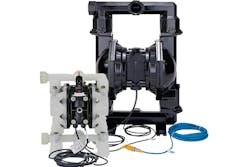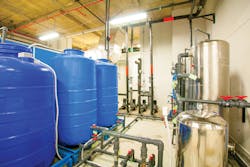Electronic interface capabilities for smarter chemical processing
For many, hearing the words "harsh chemicals" brings thoughts of fumes, flames and the ominous skull-and-crossbones image often emblazoned on dangerous chemical products. This is not entirely out of left field, considering some chemicals can injure personnel or cause severe damage to equipment. For facilities that process chemicals, employees will have some level of interaction with these chemicals. But fluid management systems can be put in place to ensure safety and the integrity of the end product.
Many chemical process operations are free of personnel
In most chemical processing facilities, operators use pumps in many transfer, metering and dosing applications. This includes transferring fluid from one container to another or adding active ingredients to the fluid to create specific products such as detergents or paints. To conduct these applications, air-operated double diaphragm (AODD) pumps are ideal because they can handle shear-sensitive products, pass solids, run dry and provide variable flow rates. AODD pumps are also easy to clean and considered low-maintenance when compared to other types of pumps. Low-maintenance pumps are particularly attractive in manufacturing environments in which products are created at high volumes and where process efficiency is important.
To ensure efficiency and safety, many chemical process operations are free of personnel. That is because many facilities operate their processes in centralized control rooms. With the possibility of spills and the impact of extended exposure to harsh chemicals, the less time spent in that environment, the better. Distance from chemicals decreases safety risks and allows process and plant engineers to focus on performance and quality.
ARO electronic-interface diaphragm pumps
Automated processes for a better batch
Automation in manufacturing has been prevalent since the 11th century when early mining innovations began to influence past practices. Over the years, processes have become more integrated, automated and digital given the need for productivity, safety and process control.
In manual pump transfer applications, an employee must be present to check on the container into which the fluid is being pumped to make sure it does not overflow. Depending on the size of the container, that could mean that one person has to wait for long periods of time to close a fluid valve once the desired volume is reached. Not only is this labor intensive, it also introduces human error risks. In many cases, operators have been known to come back to the container too late, leading to spillage or product ratio formulation errors and resulting in discarded batches and lost time.
“Pumps with electronic interface capabilities eliminate inaccuracies with precise monitoring and dosing while saving resources by freeing up operators from having to stand over the pump.”
Pumps with electronic interface capabilities eliminate these inaccuracies with precise monitoring and dosing while saving resources by freeing up operators from having to stand over the pump, which also increases overall productivity.
Smarter systems create better products
The Industrial Internet of Things (IIoT) is an evolving network of connecting systems and a broad trend in the fluids industry. Many in the industry are turning to data-driven technology by harnessing sensor data and incorporating machine-to-machine communication and automation technologies that have existed in industrial settings for years. By turning to the IIoT, manufacturers are gradually improving productivity, quality control, efficiency and safety.
Given that IIoT technologies make chemical fluid management processes smarter, it is vital for process engineers to explore how an electronic-interfacing AODD can drastically improve process control and monitoring. Technology has come a long way when it comes to controllers tailored to monitor/control AODDs. These AODD controllers enable seamless integration of sensor signals to accurately measure flow rates, control AODD pumps via electronic solenoids and monitor diaphragm health using leak-detection sensors. These functions can save labor with seamless installation in the field to get the pumps up and running quickly.
Now chemical processes can take place without constant monitoring from people.
Once installed, these pump systems automatically maintain fluid levels, which minimizes the need for operators to monitor the process. In batching applications, this is critical because it ensures the final product’s ingredients will meet the exact measurements required to ensure product quality. Remote triggers that signal auto-shutdowns and send critical operating data and maintenance service alerts to operators are also available. Leak-detection sensors can be specified to notify operators when a diaphragm failure occurs, enhancing employee safety, preventing costly material spills and minimizing repair time.
Staying smart with electronic interface capabilities
Many chemical plants have already embraced automated and data-driven processes and shifted away from inaccurate and inefficient manual processes. Even with those improvements in place, it is necessary for chemical manufacturers to use the information gathered from the AODD sensors to improve system performance. The specific integration of electronic-interface system elements previously mentioned can help manufacturers aggregate data to increase production, reduce downtime, improve processing efficiency and maintain the highest safety standards.
Julien Bassett is the global product manager for diaphragm pumps at ARO with more than 15 years of experience in engineering and product development. He leads the development of technical fluid management products designed for performance and serviceability. For more information, call 800-495-0276.




